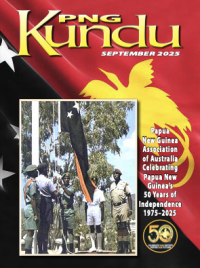Kina & Toea: 50 Years

 The denomination names of Papua New Guinea’s currency, kina and toea, originated from traditional shell money, which was historically used for trade, in ceremonies, and as a symbol of wealth amongst Papua New Guineans and their communities. These linkages continue to unite coastal and highlands peoples to the enduring significance of Papua New Guinea’s cultural heritage.
The denomination names of Papua New Guinea’s currency, kina and toea, originated from traditional shell money, which was historically used for trade, in ceremonies, and as a symbol of wealth amongst Papua New Guineans and their communities. These linkages continue to unite coastal and highlands peoples to the enduring significance of Papua New Guinea’s cultural heritage.
On 21 April 1975, the six first coin denominations from one toea to one kina of the new nation of Papua New Guinea were issued. Official First Day Cachets combining proof coin sets and commemorative stamps honouring Papua New Guinea’s independence and its first coinage were also issued. The newly minted kina circulated with the Australian dollar in Papua New Guinea until 31 December 1975.
These coins portray Papua New Guinea’s extraordinary wildlife, together with the symbols of the nation’s sovereignty. The coinage employs a decimal system with 100 toea equal to one kina. The kina is named after one of the region’s earliest forms of currency—the pearl shell. Toea is the name of another shell used in island barter.
The one-kina coin portrays two crocodiles. They look the same on the coin but one is the smaller, Crocodylus novaeguineae, found only on the island of New Guinea (https://en.numista.com/); the larger species is the wide ranging Saltwater or Indo-Pacific Crocodile (Crocodylus porosus). The hole in the centre is a tribute to when coins were worn on strings or carried on sticks. The reverse of this coin carries a stylised emblem of the Bank of Papua New Guinea, while the national crest of Papua New Guinea appears on the reverse of all the other coins.
Bennett’s cassowary (Casuarius bennetti), a flightless bird indigenous only to Papua New Guinea, features on the 20-toea coin. The spotted cuscus (Spilocuscus maculatus), a member of the marsupial family, is shown on the 10-toea coin.
The five-toea coin portrays the rare plateless turtle. The ornate butterfly cod, one of the many fascinating fish inhabiting coral reefs around the nation, was shown on the two-toea coin. The one-toea coin depicted a paradise birdwing (Ornithoptera paradisea) butterfly, a giant species found only in Papua New Guinea. The one and two-toea coins were withdrawn from circulation in 2006 when they became redundant.
The two largest denomination proof coins, the sterling silver ten kina and the five kina, minted in .500 silver, were contained in the commemorative First Day Cachets.
The Raggiana Bird of Paradise—the national bird of Papua New Guinea—is portrayed on the largest denomination coin, the ten kina. The five stars of the Southern Cross constellation appear with the bird just as they do on the national flag. This coin was combined in a cachet with the 30-toea independence stamp, which depicts the national crest along with a map of Papua New Guinea and the surrounding islands.
 The five-kina coin depicts the Papuan Harpy Eagle (Harpyopsis novaeguineae) or Tarangau in Tok Pisin, and was combined in a cachet with the seven-toea stamp, which depicts the national flag and a map showing the location of Papua New Guinea.
The five-kina coin depicts the Papuan Harpy Eagle (Harpyopsis novaeguineae) or Tarangau in Tok Pisin, and was combined in a cachet with the seven-toea stamp, which depicts the national flag and a map showing the location of Papua New Guinea.
Papua New Guinean visual artist Grim Jordan was commissioned by the Bank of Papua New Guinea in 2023 to design a piece of art now featured on the 50-kina bank note for the Bank’s 50th Anniversary.
Andrea Williams
with reference to First Day Cachets issued 21 April 1975


